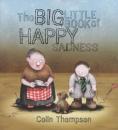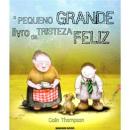AustLit
Latest Issues
AbstractHistoryArchive Description
'George lives with his grandmother and a big empty space where his mother and father should be.
'One Friday on his way home from school, George visits the animal shelter. There, in the very last cage, is Jeremy, a sad dog who looks as lost and lonely as George feels.
'When Jeremy comes home to live with George and his granny, their whole lives change, and they learn that when it comes to love, it's quality not quantity that counts ...' (Publisher's blurb)
Notes
-
This is affiliated with Dr Laurel Cohn's Picture Book Diet because it contains representations of food and/or food practices.
Food depiction - Incidental
Food types - Everyday foods
- Everyday drinks
Food practices - Food preparation
- Food serving
Gender - Food preparation - female [domestic]
- Food serving - female
Signage n/a Positive/negative value n/a Food as sense of place - Domestic
Setting - Domestic interior
Food as social cohesion n/a Food as cultural identity - White Australian characters
Food as character identity n/a Food as language n/a
Affiliation Notes
-
This work is affiliated with the AustLit subset Asian-Australian Children's Literature and Publishing because it has been translated into Korean.
Publication Details of Only Known VersionEarliest 2 Known Versions of
Other Formats
- Also braille.
Works about this Work
-
What Are We Feeding Our Children When We Read Them a Book? Depictions of Mothers and Food in Contemporary Australian Picture Books
2016
single work
criticism
— Appears in: Mothers and Food : Negotiating Foodways from Maternal Perspectives 2016; (p. 232-244)'This chapter explores how Australian writers and illustrators in the twenty-first century depict the act of mothering in picture books for young children in relation to cooking and serving food. It draws on the idea that children’s texts can be understood as sites of cultural production and reproduction, with social conventions and ideologies embedded in their narrative representations. The analysis is based on a survey of 124 books that were shortlisted for, or won, Children’s Book Council of Australia awards between 2001 and 2013. Of the eighty-seven titles that contain food and have human or anthropomorphised characters, twenty-six (30 percent) contain textual or illustrative references to maternal figures involved in food preparation or provision. Examination of this data set reveals that there is a strong correlation between non-Anglo-Australian maternal figures and home-cooked meals, and a clear link between Anglo-Australian mothers and sugar-rich snacks. The relative paucity of depictions of ethnically unmarked mothers offering more nutritious foods is notable given the cultural expectations of mothers as caretakers of their children’s well-being. At the same time, the linking of non-Anglo-Australian mothers with home-cooked meals can be seen as a means of signifying a cultural authenticity, a closeness to the earth that is differentiated from the normalised Australian culture represented in picture books. This suggests an unintended alignment of mothers preparing and serving meals with “otherness,” which creates a distancing effect between meals that may generally be considered nutritious and the normalised self. I contend there are unexamined, and perhaps unexpected, cultural assumptions about ethnicity, motherhood, and food embedded in contemporary Australian picture books. These have the potential to inscribe a system of beliefs about gender, cultural identity, and food that contributes to readers’ understanding of the world and themselves.'
Source: Abstract.
-
Untitled
2008
single work
review
— Appears in: Fiction Focus : New Titles for Teenagers , vol. 22 no. 3 2008; (p. 54)
— Review of The Big Little Book of Happy Sadness 2008 single work picture book -
Untitled
2008
single work
review
— Appears in: Fiction Focus : New Titles for Teenagers , vol. 22 no. 3 2008; (p. 54)
— Review of The Big Little Book of Happy Sadness 2008 single work picture book -
[Review] The Big Little Book of Happy Sadness
2008
single work
review
— Appears in: Books Buzz , April no. 3 2008; (p. 3-4)
— Review of The Big Little Book of Happy Sadness 2008 single work picture book -
Broken Wings, Missing Legs and Eggs
2008
single work
review
— Appears in: The Sydney Morning Herald , 21-22 June 2008; (p. 32-33)
— Review of How To Heal a Broken Wing 2008 single work picture book ; The Big Little Book of Happy Sadness 2008 single work picture book ; Big Red Hen and the Little Lost Egg 2008 single work picture book
-
Surprises, Tricks and Hope on the Page
2008
single work
review
— Appears in: The Canberra Times , 12 April 2008; (p. 16)
— Review of Tomorrow 2008 single work picture book ; The Big Little Book of Happy Sadness 2008 single work picture book -
Broken Wings, Missing Legs and Eggs
2008
single work
review
— Appears in: The Sydney Morning Herald , 21-22 June 2008; (p. 32-33)
— Review of How To Heal a Broken Wing 2008 single work picture book ; The Big Little Book of Happy Sadness 2008 single work picture book ; Big Red Hen and the Little Lost Egg 2008 single work picture book -
[Review] The Big Little Book of Happy Sadness
2008
single work
review
— Appears in: Books Buzz , April no. 3 2008; (p. 3-4)
— Review of The Big Little Book of Happy Sadness 2008 single work picture book -
Untitled
2008
single work
review
— Appears in: Fiction Focus : New Titles for Teenagers , vol. 22 no. 3 2008; (p. 54)
— Review of The Big Little Book of Happy Sadness 2008 single work picture book -
Untitled
2008
single work
review
— Appears in: Fiction Focus : New Titles for Teenagers , vol. 22 no. 3 2008; (p. 54)
— Review of The Big Little Book of Happy Sadness 2008 single work picture book -
What Are We Feeding Our Children When We Read Them a Book? Depictions of Mothers and Food in Contemporary Australian Picture Books
2016
single work
criticism
— Appears in: Mothers and Food : Negotiating Foodways from Maternal Perspectives 2016; (p. 232-244)'This chapter explores how Australian writers and illustrators in the twenty-first century depict the act of mothering in picture books for young children in relation to cooking and serving food. It draws on the idea that children’s texts can be understood as sites of cultural production and reproduction, with social conventions and ideologies embedded in their narrative representations. The analysis is based on a survey of 124 books that were shortlisted for, or won, Children’s Book Council of Australia awards between 2001 and 2013. Of the eighty-seven titles that contain food and have human or anthropomorphised characters, twenty-six (30 percent) contain textual or illustrative references to maternal figures involved in food preparation or provision. Examination of this data set reveals that there is a strong correlation between non-Anglo-Australian maternal figures and home-cooked meals, and a clear link between Anglo-Australian mothers and sugar-rich snacks. The relative paucity of depictions of ethnically unmarked mothers offering more nutritious foods is notable given the cultural expectations of mothers as caretakers of their children’s well-being. At the same time, the linking of non-Anglo-Australian mothers with home-cooked meals can be seen as a means of signifying a cultural authenticity, a closeness to the earth that is differentiated from the normalised Australian culture represented in picture books. This suggests an unintended alignment of mothers preparing and serving meals with “otherness,” which creates a distancing effect between meals that may generally be considered nutritious and the normalised self. I contend there are unexamined, and perhaps unexpected, cultural assumptions about ethnicity, motherhood, and food embedded in contemporary Australian picture books. These have the potential to inscribe a system of beliefs about gender, cultural identity, and food that contributes to readers’ understanding of the world and themselves.'
Source: Abstract.





